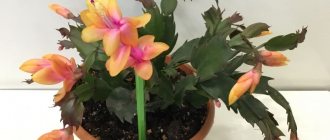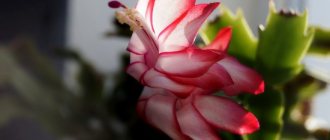From the rainforest to the windowsill
Decembrist is a popular plant belonging to the genus Schlumbergera (lat.). Until the early 90s it was part of the genus Zygokaktus, and this name can still be found. In fact, the correct name for this attractive and very popular plant is Schlumbergera trunctata. The name was given in honor of the Frenchman Frederic Schlumberger, who lived in the 19th century, a famous collector and cultivator of cacti. On the other hand, the plant owes the term “Decembrist” to its unusual winter flowering season.
People buy this flower as a New Year's decoration or gift. Zygocactus is a long-lived plant that grows for 10-20 years in an apartment. However, you need to know how to grow it so that it maintains a festive mood for many years.
The Christmas cactus originates from Brazil. The plant is an epiphyte, that is, it grows on the crowns of tropical trees. Decembrist shoots can hang freely from trees up to several tens of centimeters! Sometimes this flower also grows on rocks covered with vegetation (in rock cavities). It was supposedly a garden plant once cultivated by local tribes.
Zygocactus came to Europe in the 19th century and almost immediately became a favorite flower. After a period of slight oblivion, this plant returned to the windowsills. In winter it beautifully decorates apartments with bright flowers, and in summer it grows on balconies, terraces or even directly on flower beds.
Why is Schlumberger sluggish?
It is a mistake to think that lethargy of stems indicates a lack of moisture. Everything is completely the opposite - the plant is overwatered. As a result of this, the roots cease to perform their functions of delivering nutrients. The drastic solution will be to replant and remove damaged roots. All cuts are processed with crushed coal.
If the plant is in the flowering stage, then the need for replanting is decided based on the rate of wilting. After the procedure, all buds and flowers will fall off.
Slightly wilted leaves can be revived without replanting. It is enough to wait a little while watering and place the flower closer to the heating device. Every day it is necessary to monitor the degree of drying of the earthen clod.
Description of the succulent
The Christmas cactus has erect and drooping stems that grow up to 15-30 cm in length; the leaves consist of 5-6 cm segments. Each segment has jagged edges. The stems are flat, fleshy, clearly divided into sections, at the ends of which flowers appear up to 10 centimeters long.
Flowers with curved perianth petals of varying lengths, arranged in 2 spaced rows, creating the impression of a short fragment of a garland. Flowers are white, red, pink, yellow.
The Schlumbergera cactus usually grows alone in a pot, but can be planted in a large container with other cacti.
Zygocactus belongs to the cactus family (lat. Cactaceae), but does not behave like a typical cactus. Decembrist has no thorns or spines, but thin dark bristles may appear at the top of its dark green, shiny, leaf-shaped shoots.
Decembrist belongs to the succulent family. Plants of this type are characterized by thick, fleshy stems that store water. Succulents owe their resistance to environmental conditions to their original forms. Although they take different forms, the structure of their leaves, shoots and roots does not differ. The fabrics allow water to accumulate, which protects against environmental damage during droughts. Zygocactus stores water in its stems, shoots and roots, thanks to which it can survive in very unfavorable conditions.
Reference. Succulents grow all over the world - in Europe, Asia, America. They include a diverse group of plants, from tiny aquatic species to giant woody desert cacti. Succulents love light soil with added sand. Growing and caring for succulents is undemanding; they are usually propagated by cuttings. All succulents are usually planted shallow in a pot. Most of the group consists of cacti. Cacti differ from other succulents in that they have growth cones and so-called halos, that is, covered with hairs or down, round or elongated places from which thorns, side shoots, and flowers grow.
Vaccination
The method is very popular, since if you place its spreading crown on the trunk of another deciduous cactus (for example, pereskia or pereskiopsis), you get a standard tree that looks very impressive in the interior.
The grafting process is very painstaking and has a number of features.
A segment is selected on one of the Schlumbergera branches, which will become the grafting material. In the place where it grows from the previous segment, you need to cut off the sides with a sharp knife, giving the segment the appearance of a triangle, the acute angle of which is directed towards the previous segment. Leave the Decembrist for several days
During this time, the wounds will heal, and the damaged segment will get used to existing in conditions of limited nutrition, when communication between it and the rest of the Schlumbergera is difficult.
Attention! Sections must be treated with crushed coal or sulfur powder, because Zygocactus wounds can become infected.
The trunk of the rootstock plant is cut, and the cut site is split to a depth of 1-2 cm
All instruments must be disinfected. Pinch off the prepared Decembrist segment with your hands and insert the rootstock plant into the split.
For fixation, use a needle, thread or thorn if it is used as a rootstock. The grafting site should be treated with charcoal or sulfur powder and a bag should be placed over the grafted segment to prevent drying out.
Schlumbergera may wilt and wrinkle in the first days after vaccination. But, if the operation was successful, then soon the plant comes to life and begins to grow new segments. This takes approximately 2-3 weeks.
Types and varieties
More than two hundred varieties of Decembrist are known, all of them bloom in winter. Zygocactus is not a homogeneous systematic form, and currently 9 species of this plant are known, the main types:
- Kautskyi - Schlumberger Kautsky;
- Microsphaerica;
- Opuntioides – Sh. prickly pear;
- Orssichiana - Sh. Orsichiana;
- Russelliana - S. Rousseliana;
- Truncata - Sh. truncated.
However, when growing indoor Decembrist in pots, one encounters mainly Schlumbergera truncated hybrids.
Pure varieties are rarely found in indoor cultivation. These are mainly hybrid forms. Zygocactus blooms in very different colors: from white and cream, to various shades of pink, purple, red, even yellow. Among the Decembrist varieties, the following should be noted:
- Bristol Queen - white and pink flowers;
- White Christmas – white or white-pink;
- Nicole – pink;
- Sunset Dancer – red;
- Thor Alise – bright red;
- Westland - small and red flowers;
- Dark Eva – two-color flowers: white and pink;
- Bristol Rose – two-tone: dark pink and white;
- Christmas Cheer – two-color: orange-red;
- Gold Charm – new variety, yellow.
Growing conditions
Decembrist grows and blooms better in light soil, for example, sandy (peat mixed with sand) and in cool apartments where the air is not too dry.
Requirements for planting site and soil
Decembrist should grow in a well-lit, sunny place, but not in direct sunlight. In summer it can be placed on a shady balcony, from where it should be brought into the room in September. Schlumbergera loves bright, warm places, preferably on a window. In summer, the window needs to be slightly shaded; it is better to choose a northern exposure. If the cactus is located on a window with a lot of sunlight, it must be screened, preferably with a curtain or thin blinds that diffuse the light. You can also move the plant to the west window.
In the summer, Decembrist likes to be exposed to fresh air outside the apartment, but in an area not exposed to direct sunlight, which can burn and dry out the plants.
The Christmas cactus should not be moved, especially while it is blooming! He can drop all the flowers.
Soil requirements
Zygocactus should grow in humus soil combined with coarse sand.
The best soil for Decembrist includes the following components:
- compost soil (3 parts);
- leaves (2 parts);
- sand (1 part).
Some textbooks recommend using orchid soil mixed in equal parts with compost. The mixture must be permeable, the pot needs drainage.
After planting, the plant should be watered moderately, increasing the amount of water only when new shoots appear. Then you can apply fertilizing.
Requirements for air temperature, lighting
- Decembrist blooms at temperatures up to 20 degrees Celsius and in the shade.
- Zygocactus is a short-day plant. You can adjust the flowering period throughout the year by extending it with artificial lighting.
- The best temperature for flowering is 15-16 degrees Celsius.
- Flowering will not begin if the plant is moved to another location during budding.
- The Christmas cactus does not like frequent changes of place and even rotation during flowering and rest.
- The plant is sensitive to sudden temperature changes, excessive watering, and drought.
- In summer, the plant should be kept at normal room temperature of about 20-22 °C.
Organize your holiday season
What to do to make the Decembrist bloom? Be sure to create conditions so that the plant can rest in the fall. Without this, most likely no buds will appear on the Decembrist plant. How to do it?
With the onset of the first autumn coolness, reduce watering of the Decembrist. During the rest period, it consumes a minimum of water. If you don't stop watering it frequently, its roots may rot. This will cause the plant to die.
The air temperature during this period should reach 15 degrees Celsius. At lower rates, root rot may occur. They will no longer be able to transport moisture and nutrients to the stems and branches. If the air temperature in the room reaches more than 15 degrees, then the Decembrist will not enter the resting stage. It will continue to increase the green mass of leaves, but it may never reach buds.
In the autumn season, it is important that the length of daylight does not exceed eight hours. It is its contraction that is one of the natural signals for the Decembrist that it is time to plant buds.
Photo from the site: klumba.guru
Planting, cultivation and care
To achieve beautiful flowering and grow a healthy plant, you need to know how to care for Decembrist at home. Contrary to its name, it can bloom not only in December. If you take good care of it, it will bloom more than once a year.
Watering
Caring for the Decembrist at home should ensure an optimal watering regime. In order for the Christmas cactus to have beautiful flowers, you need to give the plant a three-month rest from August to October. It is worth moving it to a cool room and reducing watering. Decembrist grown at home should not be fed or watered at ambient temperatures below 13 degrees.
In November, the cactus can be returned to its permanent place. Then watering and fertilizing are resumed to stimulate bud formation.
Attention! It is necessary to spray the leaves of Decembrist, especially in winter, when the temperature does not exceed 18 degrees. Zygocactus requires a humidity of at least 40%. The plant grows naturally in tropical forests, so it loves moist air. You only need to spray the shoots themselves; wet buds and flowers will fall off.
Decembrist needs to be watered regularly, preventing the soil from completely drying out or water from accumulating in the pot, which can cause root rot.
How to water Decembrist at different times
| Period of time | Irrigation rates |
| June – September | Water every 3-5 days with soft water. |
| At rest (August – October) | Watering the Decembrist is carried out once a week. |
| November – January | Watering should be a little more generous from the time the flower buds appear until they bloom. |
| February March | After flowering, zygocactus loses its characteristic shine on the shoots. This is a normal sign of going on vacation. During this period, plants should be watered minimally and only when the shoots begin to wrinkle. Water during rest only so that the soil in the pot does not dry out completely. |
| Until the end of May | After about 8 weeks of rest, you can begin to water the zygocactus sparingly. Until the end of May - water every 15 days. If new shoots appear at this time, they should be pruned. |
If the cactus is accidentally flooded with water, you need to dry the soil thoroughly. If the plant begins to rot and cannot be saved, you can make new plants from it by cutting the shoots into cuttings.
Fertilizer
They begin to feed Decembrist when the plant's dormant period ends or buds appear. During the growth period (winter, spring and the first half of summer), zygocactus should be fed 1-2 times a month with liquid fertilizers for cacti (succulents). It is recommended to add cow dung fertilizer directly to the soil. The best fertilizer should be rich in potassium and nitrogen, and contain iron, magnesium, copper, molybdenum, barium, and manganese.
From August until the first flower buds appear, you should stop fertilizing and reduce watering.
It is recommended to fertilize Decembrist every 2 weeks during the flowering period.
Something to remember! Too much nitrogen can inhibit flowering.
Reproduction
Decembrist is extremely easy to propagate. Every few years it is worth growing young specimens that are more compact, attractive, and bloom more profusely than older ones. This succulent is easily propagated by cuttings taken from shoots. To do this, it is enough to have one fairly old branched shoot. Reproduction is best done after flowering. The work order is as follows:
- Very delicately cut off a piece of the process, consisting of 2-3 members.
- The cuttings are dried for a day. Cut cuttings left for some time without water will not wither, since there is enough water reserves. The cuttings are planted in the ground only after scarring at the cut sites.
- The cuttings are placed in sandy (peat with sand) slightly moist soil and placed in the shade. The cuttings are placed deep enough in the ground so that the stem stands upright. You can cover the plant with film for quick rooting.
- Water and prevent the soil from drying out.
Rooting usually lasts 3-6 weeks.
The second method is to germinate cuttings in water.
To do this, the following work is carried out:
- Trim a shoot with at least three members.
- Place the shoot in water for 2-3 weeks.
- After this time, roots should appear.
- Prepare a pot suitable for the size of the seedlings.
- Expanded clay, stones or a broken clay pot are placed at the bottom. This will prevent stagnation of water at the bottom of the pot, which the zygocactus cannot tolerate. Then add some soil and plant the plant. Gently press down the soil around the seedlings so that they do not fall, and water them.
The young plant should bloom in a few months.
Photo. Sometimes the Decembrist himself gives roots.
The second method gives a 99% guarantee that the plant will be well accepted. With the first method, sometimes seedlings can rot.
You cannot feed a plant that is too young. Fertilizer feeding begins only a few months after planting.
Transfer
The Decembrist flower does not cause trouble and does not require frequent replanting. Zygocactus should be replanted in March - May, preferably every 3-4 years, into fresh, well-drained cactus soil. This could be as simple as replacing the soil in the same pot.
Pests and diseases
- When the air becomes too dry in winter, the plant may be attacked by mealybugs or felt mites. These pests produce a felt-like substance that protects them from environmental damage and insecticides. Felt beetles live in colonies, on less accessible parts of the plant, for example, in the axils of leaves. They are very tenacious, and many sprays have no effect on them, especially on young specimens. You can remove pests with a brush dipped in water and laundry soap.
- The plant can be attacked by aphids, less commonly by spider mites and scale insects. Special insecticides are used to control insects. It is also recommended to change the soil.
- The cause of many zygocactus diseases is excess water. In a wet and cold state, zygocactus can suffer from root rot. The symptom of rot is a black border at the base of the shoot caused by fungi. When damage to the roots is visible, the affected areas are removed. It is also advisable to replant the plant in fresh soil. Watering is limited until wounds heal. You can also use antifungal drugs with added zinc and copper.
- If the position is too sunny, the shoots may turn pinkish-red and burn.
- The buds may fall off due to a sudden change in position.
Photo. The Decembrist leaf withered as a result of being attacked by spider mites.
Why doesn't the Decembrist bloom?
The Christmas cactus blooms from December until late winter. However, for it to bloom, a number of conditions must be met:
- A Christmas boy should rest twice a year. The first holiday falls at the turn of February and March, and the second lasts from August to October.
- From August to October, the plant should be moved to a cool place with a temperature of 8-10 ºC.
- The home Decembrist will give flowers provided there is at least 10 hours of complete darkness per day for 3 months (August-October), that is, until flowering. Even the light of a light bulb affects the extension of daylight hours for a plant. Even diffused light from another room extends daylight hours.
- Poor lighting during the day also makes it difficult to set flowers. The flower does not tolerate too much sun. Sometimes flower growers wonder why the leaves of the Decembrist turned red or turned purple. Direct midday sunlight burns the plant, the leaves wither, fall off, and turn purple. The plant needs 2-4 hours of intense sunlight per day, preferably in the evening or early morning.
- Poor watering. This tropical plant does not like drought. The soil in the pot should not dry out completely.
- The air temperature is too high (above 20 ºC) and the position is too shady.
- Excessive nitrogen fertilization.
- A pot that is too large contains a lot of soil, which absorbs a lot of water. The Decembrist has a small root system and does not use all the moisture, as a result, rotting and falling off of flower buds can occur; a blooming Decembrist can drop its flowers. The plant should be grown in small pots.
- Unstable conditions. Too rapid changes in growing conditions - temperature changes, changes in humidity, decrease or increase in light intensity, drafts lead to the dropping of flowers and buds.
Decembrist itself is not a very ornamental plant, but when it blooms, it amazes with its appearance. The plant is showered with white, pink, purple, red, salmon and yellow flowers, growing singly or in pairs. Growing and caring for this plant does not cause problems, but abundant flowering requires certain treatments. It is worth knowing how to properly grow Decembrist so that it pleases you with its beauty.
Decembrist: how to care for it to bloom?
How to make Decembrist bloom at home? In order for the Decembrist to bloom, you need to make sure that they are optimal:
- watering;
- temperature;
- the soil;
- lighting;
- frequency of transfers;
- feeding;
- location.
If all these factors are taken into account, the plant will definitely throw out buds and get ready to bloom. Well, now, in order, how to help the Decembrist bloom.
Photo from the site: pro100-cvety.ru











